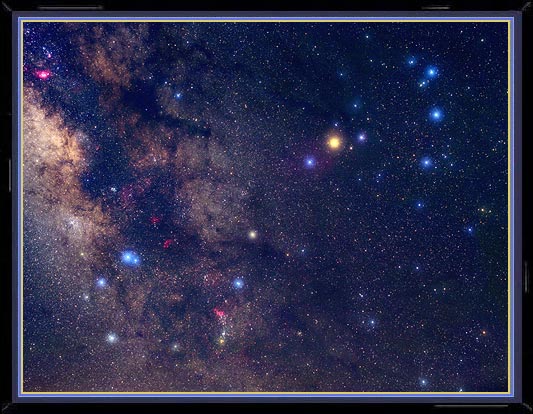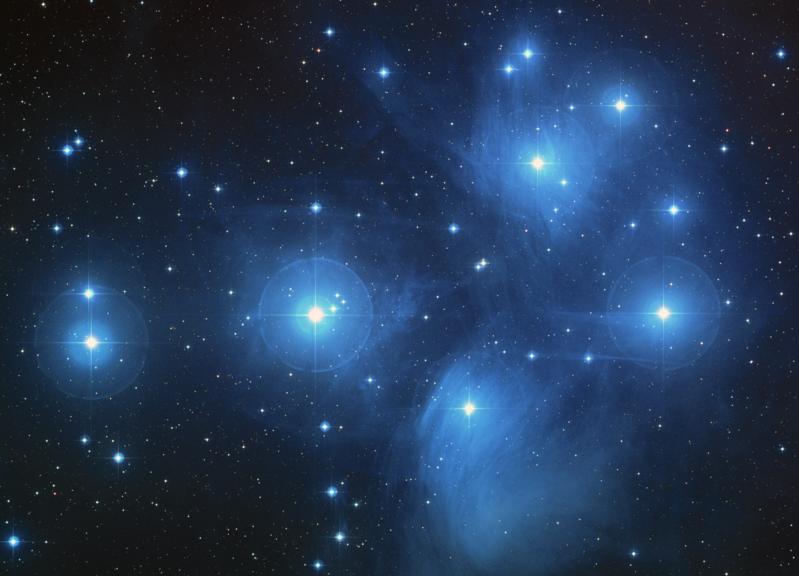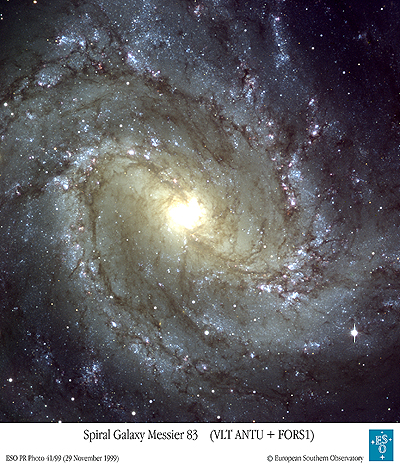







| BOOKS | F. A. Q. | ARTICLES | TALKS | ABOUT KEN | DONATE | BEYOND OUR KEN |
|---|
By Ken Croswell
Published in Star Date (July/August 2005--cover story)

 Mythological enemies Orion (left) and Scorpius (right) owe their brilliance to Gould's belt. Images by Bill and Sally Fletcher. Used by permission.
Mythological enemies Orion (left) and Scorpius (right) owe their brilliance to Gould's belt. Images by Bill and Sally Fletcher. Used by permission.
For billions of years, the huge gas cloud slunk through the oblivion of intergalactic space. It skirted past the Andromeda Galaxy, trespassed into the Milky Way's dark halo, and dodged a star cluster along our Galaxy's frontier. Fifty million years ago, the wayward gas cloud smashed into the Milky Way's disk. The gas in the cloud compressed gas in the Milky Way, triggering the birth of thousands of brilliant new stars.
But the fireworks were just beginning. Many of the newborn stars were big, hot, and blue, so within a few million years they exploded, sending supernova shock waves storming outward, like waves from a boulder thrown into the sea. The shock waves compressed additional gas, launching the birth of new stars in an expanding ring, so that today bright blue stars circle the sky from Orion to Scorpius and back again.
Known as Gould's belt, this ring of superstars spans more than 2,000 light-years, but no one knows what caused it. "You're looking for the smoking gun," says astronomer Fred Bruhweiler at the Catholic University of America, "but a lot can happen in 50 million years." A collision with an intergalactic gas cloud is only one possibility. Other theories invoke a hypernova, a gamma-ray burst, or a series of supernovae sparked by a passing spiral arm.
Whatever its cause, no one disputes its magnificence. Gould's belt is the most prominent starry feature in the Sun's neighborhood, contributing most of the bright young stars nearby. Nearly two thirds of the massive stars within 2,000 light-years of the Sun belong to Gould's belt. If I were kidnapped by an alien spaceship and taken to some remote corner of the Galaxy, Gould's belt is what I'd look for to find my way back home.
Who discovered Gould's belt? Not quite Gould. Instead, Englishman John F. W. Herschel, observing from the Cape of Good Hope in South Africa, first described "the zone of large stars which is marked out by the brilliant constellation of Orion, the bright stars of Canis Major, and almost all the more conspicuous stars of Argo [modern Puppis, Vela, and Carina]--the Cross--the Centaur, Lupus, and Scorpio."
Herschel also noted a key trait of this starry belt. It's tilted about 20 degrees to the Milky Way. He speculated that it probably formed "part of a subordinate sheet or stratum deviating to that extent from parallelism to the general mass which, seen projected on the heavens, forms the Milky Way."
Herschel published his claim in 1847. Meanwhile, in Germany, Boston-born Benjamin A. Gould was about to become the first American to earn a doctoral degree in astronomy. Seeking to elevate American astronomy to European standards, he went on to found The Astronomical Journal, which is still a mainstay of the field.
Gould later traveled to Argentina. "I desire to mention a fact which early attracted and repeatedly compelled my attention during my residence in South America," he wrote in 1874. "[A] great circle or zone of bright stars seems to gird the sky, intersecting with the Milky Way at the Southern Cross, and manifest at all seasons." Whereas Herschel had traced the southern half of Gould's belt, Gould was able to discern the belt around the entire sky.
Gould's belt stands out most in bright blue stars, which modern astronomers know are massive, short-lived, and thus young. B-type stars brighter than magnitude 5.25 delineate the belt--the brightest such star is Rigel--whereas B stars fainter than magnitude 6.25 outline the Galactic plane, because they lie beyond Gould's belt.
 Gould's belt elevates stars that otherwise would be so far south as to be invisible from mid-northern latitudes. In particular, if you live at a northerly latitude, you can thank the odd tilt for providing your view of the spectacular constellation Scorpius. Without Gould's belt, the constellation's brightest stars would lurk in the murk of the southern horizon. Instead, the red supergiant Antares, the two blue stars on either side of it, and the Scorpion's crooked head shine far to the north, visible even in Canada. All these stars are or were blue, and all belong to Gould's belt. Antares, for example, hovers 15 degrees north of the Galactic plane. Gould's belt likewise raises the bright stars of neighboring Lupus and Centaurus. All three constellations, plus Crux and Ophiuchus, feature the Scorpius-Centaurus OB association, the nearest group of massive, supernova-producing stars, 500 light-years away. Since Antares has evolved into a red supergiant, it likely will be the next to explode.
Gould's belt elevates stars that otherwise would be so far south as to be invisible from mid-northern latitudes. In particular, if you live at a northerly latitude, you can thank the odd tilt for providing your view of the spectacular constellation Scorpius. Without Gould's belt, the constellation's brightest stars would lurk in the murk of the southern horizon. Instead, the red supergiant Antares, the two blue stars on either side of it, and the Scorpion's crooked head shine far to the north, visible even in Canada. All these stars are or were blue, and all belong to Gould's belt. Antares, for example, hovers 15 degrees north of the Galactic plane. Gould's belt likewise raises the bright stars of neighboring Lupus and Centaurus. All three constellations, plus Crux and Ophiuchus, feature the Scorpius-Centaurus OB association, the nearest group of massive, supernova-producing stars, 500 light-years away. Since Antares has evolved into a red supergiant, it likely will be the next to explode.
On the opposite side of the sky, Gould's belt depresses the elevation of Scorpius's mythological enemy, Orion. But it doesn't hurt northern stargazers, because there the Milky Way is sufficiently far north that all can still see this most dazzling of constellations. Observe Orion on a dark moonless night and notice how the Milky Way almost misses it, running through only its northern reaches. Orion's brightest stars dangle to the south. For example, blue Rigel is 25 degrees below the plane of the Galaxy.
 The Scorpius-Centaurus and Orion OB associations are the jewels of Gould's belt, but it has plenty of other gems. Gould's belt is an elliptical ring of OB associations that surrounds the Sun. According to work published in 2003 by Christophe A. Perrot and Isabelle A. Grenier of the University of Paris, the ellipse measures 2,400 by 1,500 light-years.
The Scorpius-Centaurus and Orion OB associations are the jewels of Gould's belt, but it has plenty of other gems. Gould's belt is an elliptical ring of OB associations that surrounds the Sun. According to work published in 2003 by Christophe A. Perrot and Isabelle A. Grenier of the University of Paris, the ellipse measures 2,400 by 1,500 light-years.
The Sun lies inside Gould's belt, but off-center. Most studies put the center of Gould's belt around Perseus, several hundred light-years from the Sun. However, Perrot and Grenier say the center lies near neighboring Taurus, opposite the Milky Way's center, at a distance of only 340 light-years. This is closer than the Pleiades, another Taurus resident.
When massive stars like those in Gould's belt explode, they leave behind pulsars and black holes. In the late 1990s, Grenier noted that the Compton Gamma Ray Observatory recorded several dozen sources which track the path of Gould's belt around the sky. No one knows what these gamma-ray sources are, but they may be pulsars or black holes--cinders left behind by the explosion of the first generation of brilliant stars that once illuminated Gould's belt.
In 1996 Rainer Wichmann at Hamburg Observatory in Germany and colleagues identified 48 T Tauri stars--precursors of Sunlike stars--in and around the constellation Lupus. The stars stood out because they had lots of lithium, an element stars destroy as they age and thus a signature of youth. Bearing spectral types F, G, K, and M, the four dozen T Tauri stars lined up not with the Galactic plane but with Gould's belt. They had a lofty Galactic latitude of about 18 degrees.
Recent x-ray studies of such stars have revealed that Gould's belt is probably not a ring but instead a disk. Young, fast-spinning suns often emit copious x-rays, and in 1998 Patrick Guillout at Strasbourg Observatory in France and his colleagues mapped x-ray sources detected by the ROSAT satellite. Guillout's team found that the x-ray sources followed Gould's belt over at least half the sky.
"It was quite a surprise," Guillout says. "The sensitivity of the ROSAT sky survey was not sufficient to detect significant numbers of stars at the distance of Gould's belt." Yet by cross-correlating the ROSAT data with data from the Hipparcos satellite, which recorded distances to nearby stars, Guillout's team came up with over 6,000 matches. Most are probably young, active stars having spectral types F and G. They delineate Gould's belt especially well from Orion south through Carina and into Centaurus and Scorpius, where Gould's belt comes closest to the Sun.
Still, Gould's belt doesn't come close enough to explain all the detections. Guillout therefore proposes that Gould's belt is really a disk. In his view, the bright blue stars merely mark the outer boundary of Gould's disk. Lesser stars shine at nearer distances, within range of ROSAT. At its closest, in Centaurus, the disk is only about 100 light-years from the Sun. In the future, Guillout will use x-ray data from the more sensitive XMM Newton satellite. Then he hopes to detect young, x-ray-emitting Gould-belt stars all around the sky.
Interstellar gas and dust--the raw materials from which new stars are born--also trace Gould's belt. As early as 1922, Edwin Hubble noticed that many interstellar nebulae followed the path of Gould's belt around the sky. In the 1960s, Swedish astronomer Per Olof Lindblad discovered a ring of neutral hydrogen gas that did the same. Indeed, the gas and dust account for most of the mass in Gould's belt, outweighing its stars. Two of the best-known gaseous members are the Orion Nebula and the Rho Ophiuchi cloud.
At first, a supernova might seem the way to explain Gould's belt. Its shock waves could have piled up gas and dust in an expanding ring of star formation. But this won't work. A single supernova doesn't pack enough punch. And supernovae elsewhere, such as in the Scorpius-Centaurus association, haven't created anything as grand as Gould's belt.
Instead, perhaps a series of supernovae--from massive stars whose birth was triggered by the passage of a Galactic spiral arm--did the trick. But why haven't spiral arms elsewhere created similar structures? Other possibilities include the rare explosion of a hypernova or gamma-ray burst. Trouble is, none of these theories explain the peculiar tilt that Gould's belt makes with the Galactic plane.
So perhaps an intruder did the dirty deed. Astronomers know that gas clouds hit the Milky Way, as do entire galaxies. If an intergalactic gas cloud struck the Milky Way's disk at an angle of about 20 degrees from the perpendicular, it might have compressed the Galaxy's own gas and triggered a tilted wave of star formation resembling Gould's belt.
"This is very much conjecture," says Fernando Comer�n of the European Southern Observatory in Germany, one of the astronomers who proposed the idea. "No mechanism--or combination of mechanisms--is ruled out." He notes that the various ideas may have worked in tandem. A colliding gas cloud may have started the birth of stars, then supernova explosions enhanced the star-formation rate.
A logical place to look for the culprit is the center of Gould's belt. As it turns out, not far from that point lies the Alpha Persei cluster, some 600 light-years from Earth. It's about 50 million years old. Surrounding this cluster is the loose Cassiopeia-Taurus association of stars. Perhaps the stars here were the site of a Galactic "ground zero" that created Gould's belt. Alpha Persei and the Cassiopeia-Taurus association may themselves have been created by a passing spiral arm or the collision of an intergalactic gas cloud.
In the future, astronomers hope to refine their view of Gould's belt through better distance measurements. By determining parallaxes and thus distances, the Hipparcos satellite was a good start, but most of Gould's belt is beyond the reach of Hipparcos. In the 2010s, however, the European Space Agency plans to launch the GAIA satellite, which promises to offer precise parallaxes for stars thousands of light-years away. That should include all stars in Gould's belt bright enough for the satellite to detect.
Meanwhile, stargazers can enjoy the sights that Gould's belt provides. It's even possible that the Sun and the Earth owe their existence to such a starry belt--one that arose and dispersed billions of years ago.
Ken Croswell earned his doctorate at Harvard University for investigating the Milky Way, subject of his book The Alchemy of the Heavens. He is also the author of Magnificent Universe and See the Stars: Your First Guide to the Night Sky. See the Stars features Orion as the January constellation and Scorpius as the July constellation.
"Ken Croswell's The Alchemy of the Heavens is one of the very best popular astronomy books in decades."--Keay Davidson, San Francisco Examiner. See all reviews of The Alchemy of the Heavens here.
"Magnificent Universe by Ken Croswell is elegant and eloquent."--Kathy Sawyer, Washington Post. See all reviews of Magnificent Universe here.
"Finally! An astronomy guide that the reader can actually follow without being a rocket scientist!" See all reviews of See the Stars here.
 The Pleiades star cluster. NASA, ESA, and AURA/Caltech.
The Pleiades star cluster. NASA, ESA, and AURA/Caltech.Although Gould's belt decorates the celestial horizon with bright stars, the hole in which we live deprives us of nearby luminaries. A 2001 paper by Jes�s Ma�z-Apell�niz of the Space Telescope Science Institute used parallaxes from the Hipparcos satellite to analyze the distribution of blue stars. If our region of the Galaxy were typical, twelve stars with spectral types between O and B5 would shine within 220 light-years of the Sun. In fact, says Ma�z-Apell�niz, only three do: Alkaid, at the end of the Big Dipper's handle; Achernar in Eridanus; and Alpha Pavonis.
The "local hole" contains two prominent star clusters that likely have nothing to do with Gould's belt. That's because they're too old: the Pleiades, 435 light-years away, is twice as old as Gould's belt, and the Hyades, 150 light-years away, is even older.
Both clusters are in Taurus, which may have a connection to Gould's belt through its molecular clouds. These clouds give birth to Sunlike stars. Indeed, T Tauri itself makes its home here, 21 degrees south of the Galactic plane. The Taurus clouds lie in the plane of Gould's belt 470 light-years from Earth, putting them near the center of Gould's belt.
In 1986, Carlos A. Olano and Wolfgang G. L. P�ppel of the Argentine Institute of Radio Astronomy traced the path of the Taurus clouds back in time and concluded that they had been tossed out of Gould's belt, perhaps by a supernova in Canis Major or Puppis. In the early 1990s, Richard E. White of Smith College and John Bally of the University of Colorado at Boulder proposed that a cloud thrown out of a different section of Gould's belt, in Vulpecula, is passing through the Pleiades. Thus, although the Pleiades may not have originated in Gould's belt, the gas and dust that envelop the cluster did.
 M83 image by the Very Large Telescope in Chile. European Southern Observatory.
M83 image by the Very Large Telescope in Chile. European Southern Observatory.While astronomers puzzle over the origin of Gould's belt, they can take comfort in knowing that their colleagues in other galaxies may be doing the same. In 2000, Fernando Comer�n used images from the Very Large Telescope in Chile to examine M83, a beautiful spiral galaxy some 12 million light-years away in Hydra. In M83's southeastern quadrant he identified a complex of blue stars spanning 1,500 light-years, "looking," he wrote, "much as the Gould Belt should if observed from above the galactic plane." The structure is smaller and dimmer, however, and because we view M83 nearly face-on, he can't tell whether it's tilted the way "our" Gould's belt is.
In 2001, S�ren Larsen of the European Southern Observatory and his colleagues studied another analogue to Gould's belt, this one in NGC 6946, a spiral galaxy 19 million light-years away in Cepheus. It's produced a record eight supernovae during the past century. By examining Hubble Space Telescope images, Larsen's team discovered a feature even more luminous than Gould's belt.
Whatever created it, then, Gould's belt may be more than just a curiosity that encircles the Sun and speckles the sky with brilliant stars and nebulae. It could be a feature common to spiral galaxies throughout the universe.
| BOOKS | F. A. Q. | ARTICLES | TALKS | ABOUT KEN | DONATE | BEYOND OUR KEN |
|---|